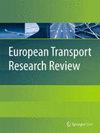调查更安全长途巴士服务的关键解释因素
IF 4.2
3区 工程技术
Q1 TRANSPORTATION
引用次数: 0
摘要
公共汽车是最方便、最常用的交通工具之一。由于其重要性,经常进行道路安全分析以减少事故。本文以马德里和毕尔巴鄂(西班牙)之间的长途服务为重点,研究了天气条件与事故原因之间的关系,以改善道路安全。我们采用了潜类聚类(LCC)和层次有序 Logit 模型来确定这些因素之间的关系。此外,我们还采用了 Kaplan-Meier 生存分析法,以提供事故发生的时间洞察力。主要结果表明,自 2019 年以来,事故呈下降趋势,而操纵是最常见的原因。LCC显示,在 "晴朗和多云天气 "下,"机动操作和汽车侵入对向车道 "的发生概率最高(63%)。分层有序对数模型表明,阴雨天气对所有事故原因都有显著影响。Kaplan-Meier 生存分析表明,在最初十天内,生存概率呈垂直下降趋势,这表明最初的事故风险较高。本研究采用的综合方法提供了对事故危害的透彻理解,这是其主要贡献所在。通过整合 LCC、层次有序 Logit 模型和 Kaplan-Meier 生存分析,我们可以对天气与公交车事故之间的联系做出全面而细致的解释。研究结果凸显了快速和持续安全干预的必要性,增强了稳健性,并为改善公共汽车安全提供了可行的见解。本文章由计算机程序翻译,如有差异,请以英文原文为准。
Investigating key explanatory factors for safer long-distance bus services
Buses are among the most accessible and frequently used means of transport. Due to its importance, road safety analysis is frequently conducted to reduce accidents. This paper studied the relationship between weather conditions and the causes of accidents to improve road safety, focusing on long-distance services between Madrid and Bilbao (Spain). We employed Latent Class Clustering (LCC) and Hierarchical Ordered Logit models to identify these factors’ relationships. Additionally, Kaplan-Meier survival analysis was adopted to provide temporal insights into accident occurrences. The main results show a downward trend in accidents since 2019, with manoeuvres being the most frequent cause. LCC reveals that “manoeuvres and car invading lanes in the opposite direction” in “clear and cloudy weather” has the highest probability of occurrence (63%). The hierarchical-ordered logit model indicates that rainy weather significantly affects all accident causes. Kaplan-Meier survival analysis reveals a vertical initial decline in survival probability within the first ten days, emphasizing a high initial accident risk. The integrated approach used in this work provides a thorough understanding of accident hazards, which is its main contribution. By integrating LCC, Hierarchical Ordered Logit models and Kaplan-Meier survival analysis; we could offer a comprehensive and nuanced interpretation of the connection between weather and bus accidents. The findings highlight the need for rapid and sustained safety interventions, enhancing robustness and providing actionable insights for improving bus safety.
求助全文
通过发布文献求助,成功后即可免费获取论文全文。
去求助
来源期刊

European Transport Research Review
Engineering-Mechanical Engineering
CiteScore
8.60
自引率
4.70%
发文量
49
审稿时长
13 weeks
期刊介绍:
European Transport Research Review (ETRR) is a peer-reviewed open access journal publishing original high-quality scholarly research and developments in areas related to transportation science, technologies, policy and practice. Established in 2008 by the European Conference of Transport Research Institutes (ECTRI), the Journal provides researchers and practitioners around the world with an authoritative forum for the dissemination and critical discussion of new ideas and methodologies that originate in, or are of special interest to, the European transport research community. The journal is unique in its field, as it covers all modes of transport and addresses both the engineering and the social science perspective, offering a truly multidisciplinary platform for researchers, practitioners, engineers and policymakers. ETRR is aimed at a readership including researchers, practitioners in the design and operation of transportation systems, and policymakers at the international, national, regional and local levels.
 求助内容:
求助内容: 应助结果提醒方式:
应助结果提醒方式:


